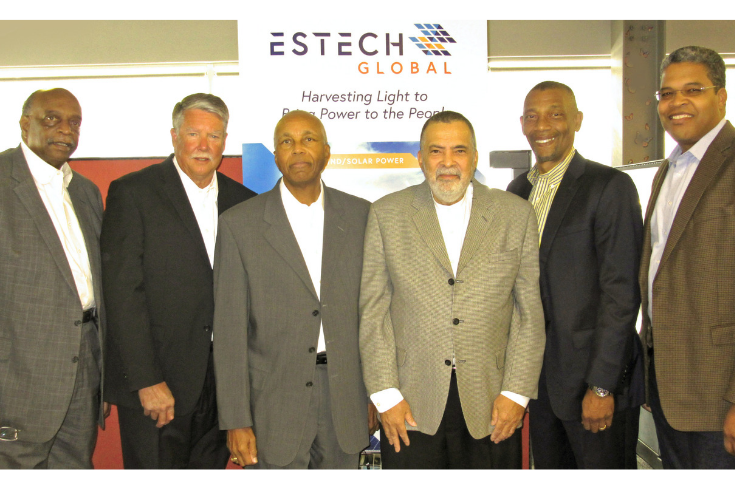New Mexico’s Rise to Renewable Power Starts Now
New Mexico has all the ingredients—geographically, meteorologically and politically—to be a national leader in renewable energy. With more than 300 days of sun a year and a new governor who is especially pro green industry, it’s predicted that New Mexico could reach 100 percent renewable electricity by 2045, if not before.
Frederick Esters is dedicated to making that goal a reality. His renewable energy startup, Estech Global, distributes solar panels, systems and components with plans to become an Albuquerque-based manufacturer.
Powered with Purpose
The ambition to grow green industry in New Mexico is deep-seated in Esters—some might even say, ordained. “I’m here with a purpose, on assignment,” he says.
Esters and his wife Danielle, a maternal fetal specialist, are ordained ministers. Since 2007, their nonprofit Prosper and Be in Health has supported the building of schools and one medical clinic in Haiti. After funding the construction of two new schools with computer rooms and high-speed internet in Anse Rouge, a city in Northwest Haiti, the diesel-powered generators proved too expensive to use daily, and toxic to the environment. “Our schools needed an alternative, sustainable green energy solution. Estech Global was founded for this reason,” Esters says. “I can’t rest until we get clean energy to those children.”
After relocating from West Palm Beach, Florida to Albuquerque, New Mexico, thanks to his wife’s new job at UNM Hospital, Esters found himself in one of the sunniest states in the nation—second only to Arizona—and home to some of the most powerful tech laboratories in the country.
Esters is currently in talks with Sandia Laboratories and Los Alamos National Labs to pursue strategic partnerships to mobilize their technologies through tech transfer. He says, “The latest tech is sitting on their shelves, and they need help bringing it to market.”
Opportune Timing
The time has never been more auspicious, says Tom Solomon, co-coordinator of 350.org New Mexico and a career electrical engineer for Intel. Solomon anticipates the rise of clean energy will happen even faster than predicted.
For an economy like New Mexico, which is heavily reliant on revenue from oil and gas, these predictions make some people bristle. An important distinction, Solomon says, is the difference between electricity and fuel. “A common misconception is that there’s a conflict between renewable electricity and oil and gas.” That’s not the case, he reassures. Coal-fired electricity is being phased out in favor of wind- and solar-generated electricity, and won’t affect the oil and gas sector—at least for now.
Plus, the incentives are stacking up. Esters points to the PACE and solar ITC tax incentives. “People think it’s challenging to start a solar project. But it’s not,” he says. “The current incentives give up to 30 percent back. A solution to global warming starts at home.”
Mitigating Boom and Bust
In the Roundhouse, solar and wind legislation continues to get the green light. The Energy Transition Act, is moving steadily through the senate. The bill calls for a transition to 50 percent renewable energy by 2030 with a goal of 100 percent by 2045, and provides economic relief for communities where coal plants will be shut down. Easing our economy’s reliance on oil and gas, however, will be a longer process.
“The market for electric vehicles is growing tremendously worldwide, around 60 percent growth each year over the past three years—especially in China, the world’s largest car market,” says Solomon. “Electric vehicles will reduce demand enough for gasoline, which will affect the amount of oil and gas extraction over time.”
In the interim, New Mexico’s economy is flush with cash from an especially profitable year in the oil and gas sector. “We’re in a sweet spot,” Solomon says. “This short term surplus gives us the opportunity to look into solving our oil dependency in the future.” Oil’s fluctuating price on the global market makes for a volatile “boom or bust” economy. The current surplus could allow New Mexico to invest in diversifying the economy before another “bust” year inevitably reoccurs. “Other states have economies that depend on the medical, tourism or manufacturing industries,” Solomon says. “There are so many options—and renewable energy is one of the most compelling.”
Diversifying the economy is where Esters comes back in. His goal is not just to make green energy affordable to consumers, profitable for the economy and beneficial for the environment—but to build a workforce pipeline.
“We have an obligation to provide training, internships and solar apprenticeship opportunities for young adults,” Esters says. “We are projecting to create up to 200 jobs, so our plan is to partner with CNM, UNM, Department of Workforce Solutions and others. Let’s create the pipeline to help retain local talent by providing more high-paying jobs here at home.”
Both Esters and Solomon agree, green industry has been a long time coming. “We should be leading the nation with our green energy portfolio,” Esters says. “New Mexico has all the tools and resources right here in our backyard. Let’s transform our state, and set a new national leadership standard.”
Upcoming event:
Grand opening and dedication of Estech Global
Thursday, March 28, 6:30 p.m. - 8:00 p.m.
5801 Bobby Foster Rd. Albuquerque, NM 87105
RSVP at https://estech.global/
Connect the Dots
There is a wealth of technology in New Mexico, as more people create companies based on those innovations, we will see opportunities and prosperity spread. Over the past five years, City Alive leadership and community partners have worked together to promote and support the creation of high-growth, homegrown technology companies. Partners like CNM and Sandia have been accelerating opportunities through new programs like IGNITE Community Accelerator and the Tech Navigator Challenge.


